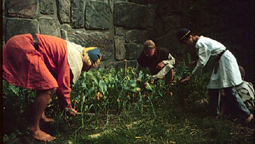Meet the Middle Ages
BackPeasants

90 per cent of the population in the Nordic countries during the Middle Ages were peasants. They made their living from farming and tending live-stock. In the forests, the peasants did forestry, made charcoal and tar or hunted to get meat , hide and fur. Were iron ore was found, one made iron. If one lived by a lake or by the sea, one fished.
The peasants produced more or less everything they needed on their farms. The income gained from selling vegetables, eggs, fish and meat was used to buy the things that they could not make or grow themselves. These could be necessary things such as shoes, iron pots and salt but also luxuries such as spices, fine cloth or wine.
Many peasants owned their own farms and paid taxes to the King - we call them free-holders. Other peasants leased their land from a nobleman, a convent, the Bishop or the Crown. These farmers were called tenant farmers and paid a fee to their landlords. They paid their rent in cash or in goods. The tenant farmer had to work a fixed number of days in a year at his landlord ´s manor. The tenant would normally lease the farm for a period of four to eight years. At the end of the period, the tenancy was renewed, but only if the tenant had taken good care of the property.
In Sweden there were many free-holders whilst only a tenth of the peasants in Denmark owned their own farms. The remaining peasants leased their farms from the nobility or the Church. On the European continent, more or less all peasants were tenant farmers under the royalty, the nobility or the Church.
In Sweden, the peasants had a fair amount of influence, and the King had to listen to what they had to say. On the European continent, the situation was quite different.
Read more about peasants under "Country Life"